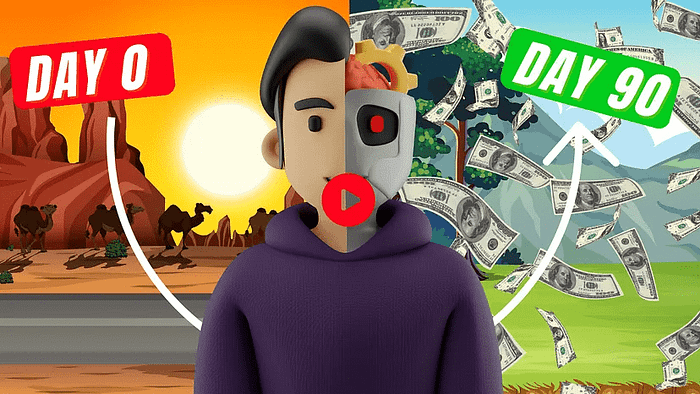I Spent $20,000 on Forex Trading with AI Bot: The Outcome
Forex trading with AI bots has become a fascinating frontier in the world of finance. As I embarked on this journey, I couldn’t help but wonder: could an AI bot outsmart human traders in the complex Forex markets?
My curiosity led me to conduct an experiment that would pit artificial intelligence against some of the most successful human traders. With a hefty $20,000 budget and a dash of skepticism, I set out to find the best-rated AI trading bot and put it through its paces.
We strongly recommend that you check out our guide on how to take advantage of AI in today’s passive income economy.
Table of Contents
The Search for the Perfect AI Trading Bot
Navigating the World of AI and Trading
As I delved into the realm of AI-powered trading, I found myself marveling at the capabilities of modern artificial intelligence.
Tools like ChatGPT have revolutionized the way we approach tasks, from writing essays to coding simple games.
This got me thinking: if AI can handle these complex tasks, surely it could tackle the intricacies of Forex trading?
My initial attempts to create a custom trading bot using ChatGPT’s coding abilities proved frustrating.
Despite the AI’s impressive language skills, the resulting Python code was riddled with errors and refused to run properly.
It became clear that I needed to find a pre-existing, battle-tested Forex trading bot for my experiment.
Sifting Through the Options
Determined to find a reputable AI trading solution, I turned to the power of crowdsourced reviews.
Forex trading with AI bots has gained significant traction, but separating the wheat from the chaff proved challenging.
I scoured TrustPilot, Reddit, and Quora, searching for the most highly-rated and reliable trading bots available.
My research led me to several promising candidates, but I quickly learned that not all that glitters is gold in the world of automated trading.
The Pitfalls of Poorly Vetted Bots
One of the first bots I encountered, the Satoshi bot, initially seemed promising based on its Google search ranking.
However, a closer look at user reviews revealed a disturbing pattern of losses and scam accusations.
Countless users reported losing thousands of dollars within weeks of using the bot.
This experience served as a stark reminder of the importance of thorough due diligence in the world of Forex trading with AI bots.
Discovering a Promising Contender
After much searching, I stumbled upon a bot that caught my attention: the Supreme EA Incubator.
What set this bot apart were its impressive verified results across multiple trading accounts.
One account, in particular, stood out – a $100,000 investment that grew by 47% in just six months, with a remarkably low maximum daily drawdown of 2.27%.
These results seemed almost too good to be true, but they piqued my interest enough to make this bot the focus of my experiment.
Setting Up the AI Trading Bot
Preparing for Launch
With my chosen bot in hand, I began the process of setting it up for my $20,000 experiment.
Forex trading with AI bots requires careful preparation, and I was determined to follow the recommended best practices.
The support team advised using a Virtual Private Server (VPS) to ensure uninterrupted trading, even if my personal computer experienced issues.
Creating a Robust Trading Environment
I opted for a basic VPS package, which proved sufficient for running the trading bot effectively.
The setup process was straightforward, involving a series of emails with login credentials and instructions.
As I connected to the VPS for the first time, I felt a mix of excitement and apprehension about the potential outcomes of my experiment.
Installing the Trading Platform
With the VPS up and running, the next step was to install the MetaTrader 4 trading platform.
This industry-standard software would serve as the foundation for my AI bot’s trading activities.
The installation process was smooth, and soon I found myself face-to-face with the familiar MT4 interface.
Choosing a Broker and Funding the Account
For this experiment, I decided to use OCTA FX as my broker.
I want to emphasize that this choice was based solely on my prior experience with their platform and favorable trading conditions.
I’m not affiliated with or sponsored by OCTA FX in any way.
Configuring the Bot
With my account funded and ready to go, it was time to configure the AI bot for action.
Following the support team’s recommendations, I set up the bot to trade on three currency pairs: GBP/USD and EUR/USD on the 1-hour timeframe, and GBP/NZD on the 15-minute chart.
The anticipation built as I prepared to unleash the AI on the Forex markets with my hard-earned $20,000.
Overcoming Technical Hurdles
An Unexpected Setback
Just as I thought everything was in place, I encountered a significant obstacle.
MetaTrader 4 had recently released an update that rendered older Expert Advisors (EAs) incompatible.
This meant that the bot files I had received from the developer were now unusable.
Adapting to the Challenge
Undeterred, I reached out to the developer to request updated EA files compatible with the latest version of MetaTrader 4.
This experience highlighted the importance of staying current with software updates in the world of Forex trading with AI bots.
It also demonstrated the need for responsive support from bot developers to ensure smooth operation.
Installing the Updated Bot
With the new files in hand, I set about installing the bot on my VPS.
The process involved carefully placing the necessary files in the correct folders within the MetaTrader 4 directory.
I double-checked each step, knowing that even a small mistake could derail my entire experiment.
Fine-Tuning the Settings
As I configured the bot’s settings, I paid close attention to the risk management parameters.
Following the developer’s guidance, I set the fixed lot size to 0.2, which they recommended for a $100,000 account.
Given that I was trading with $20,000, this seemed like a reasonably conservative approach.
Comparing AI to Human Traders
Seeking Out Human Competition
While setting up the AI bot, I couldn’t help but wonder how it would stack up against human traders.
To satisfy my curiosity, I decided to find a reputable Forex signal group to serve as a point of comparison.
After extensive research on various platforms, I settled on a group called Rogue Snipers.
Analyzing Human Trading Performance
I spent some time reviewing the Rogue Snipers’ recent performance to establish a baseline for comparison.
Their results were mixed, with some weeks showing impressive gains and others resulting in small losses.
On average, they seemed to generate about 2% profit per week, which translated to roughly 0.5% daily return.
Setting Expectations for the AI
As I prepared to activate the AI bot, I kept these human performance metrics in mind.
Would the bot be able to match or exceed the 0.5% daily return of the signal group?
More importantly, how would it handle drawdowns compared to the human traders’ maximum 3% drawdown over the year?
The AI Bot in Action
Day One: A Cautious Start
As the bot began its first day of trading, I watched with bated breath.
Forex trading with AI bots can be nerve-wracking, especially when real money is on the line.
The bot quickly opened positions on GBP/USD and EUR/USD, both short trades that aligned with my own bearish bias on these pairs.
Analyzing the Bot’s Strategy
As I observed the bot’s actions, I began to piece together its underlying strategy.
It appeared to be using a combination of Martingale and Bollinger Band techniques.
This approach can be powerful but also carries significant risks if not managed properly.
Day Three: Impressive Gains and Looming Challenges
By the third day of trading, the bot had generated a profit of $120, representing a 6% gain.
While impressive, I remained cautious, knowing that consistent performance over time is what truly matters in Forex trading with AI bots.
I was particularly interested in seeing how the bot would handle drawdowns and adverse market conditions.
Facing the Ultimate Test: Non-Farm Payrolls
As luck would have it, the third day of our experiment coincided with the release of Non-Farm Payroll (NFP) data.
This high-impact news event is known for causing significant market volatility.
Despite the support team’s advice to avoid trading during such events, I decided to let the bot continue operating.
A Nail-Biting NFP Experience
As the NFP data was released, I watched in real-time as the market reacted violently.
The bot, which had been holding short positions, found itself on the wrong side of a strong upward move.
I held my breath as the drawdown grew, reaching a stomach-churning $1,600 at its peak.
Assessing the Damage
When the dust settled, our experiment concluded with a $1,550 loss.
While disappointing, this outcome provided valuable insights into the bot’s risk management capabilities.
It became clear that the Martingale strategy employed by the bot could lead to significant losses in volatile market conditions.
Lessons Learned and Final Thoughts
The Importance of Risk Management
My experience with Forex trading with AI bots highlighted the critical role of proper risk management.
While the bot showed promising results in calm market conditions, its performance during the NFP release was concerning.
The ability to protect capital during adverse events is crucial for long-term trading success.
Human vs. Machine: A Close Call
Comparing the AI bot’s performance to the human-led signal group, I found myself leaning towards the human approach.
The signal provider’s emphasis on risking less to make more aligned better with my own risk tolerance.
However, it’s worth noting that this experiment was relatively short-term, and results could vary over a more extended period.
The Value of Personal Skill Development
Reflecting on this experience, I’ve come to appreciate the importance of developing one’s own trading skills.
While AI bots and signal services can be valuable tools, there’s no substitute for personal knowledge and experience in the Forex markets.
Learning to trade effectively is a lifelong skill that can pay dividends for years to come.
The Future of Forex Trading with AI Bots
Despite the challenges encountered in this experiment, I believe that AI will continue to play an increasingly important role in Forex trading.
As algorithms improve and risk management techniques evolve, we may see AI bots that can consistently outperform human traders.
For now, a hybrid approach combining human insight with AI assistance may offer the best of both worlds.
Conclusion
My journey into Forex trading with AI bots has been eye-opening, to say the least.
From the initial excitement of potential effortless profits to the sobering reality of significant drawdowns, this experiment has reinforced the complexity of the Forex markets.
While AI bots show promise, they are not yet the holy grail of trading that some might hope for.
As we look to the future, it’s clear that the intersection of artificial intelligence and Forex trading will continue to evolve.
Whether you choose to embrace AI tools, follow human experts, or develop your own trading skills, one thing remains certain: success in Forex trading requires dedication, continuous learning, and a healthy respect for the risks involved.
FAQs:
Is there any AI for forex trading?
Yes, there are several AI-powered solutions available for forex trading. These AI systems use advanced algorithms and machine learning to analyze market data, identify trading opportunities, and execute trades. AI tools can enhance trading strategies by processing large amounts of data quickly and adapting to market conditions in real-time. Some popular AI-driven forex trading platforms include MetaTrader with Expert Advisors (EAs), Trade Ideas, and Signal Trader.
Do forex trading bots really work?
Forex trading bots can be effective, but their success depends on various factors, including the quality of the algorithm, market conditions, and the trading strategy used. While some bots have demonstrated consistent performance and can outperform manual trading, others may not perform as well, especially in volatile or unpredictable market conditions. It’s crucial to choose a well-tested and reputable bot and to monitor its performance regularly.
Which bot is best for forex?
The best forex trading bot can vary based on individual needs and trading goals. Some widely recommended forex bots include:
- MetaTrader 4/5 with Expert Advisors (EAs): Popular for its flexibility and extensive customization options.
- Forex Fury: Known for its user-friendly interface and consistent performance.
- AlgoTrader: Offers advanced algorithmic trading features and is suitable for more experienced traders.
- 3Commas: Provides a range of automated trading strategies and portfolio management tools.
It’s important to research and test different bots to find one that aligns with your trading strategy and risk tolerance.
Are forex bots allowed?
Yes, forex bots are generally allowed and widely used in the forex trading industry. Many brokers support the use of trading bots and offer platforms that integrate with automated trading systems. However, it’s essential to ensure that the use of a forex bot complies with the regulations and policies of your chosen broker. Additionally, some brokers may have specific guidelines regarding automated trading, so it’s a good idea to review their terms and conditions before using a bot.

We strongly recommend that you check out our guide on how to take advantage of AI in today’s passive income economy.




